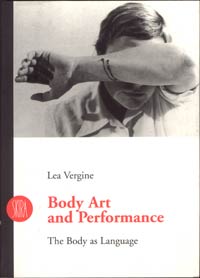Art as psychoanalysis
Lea Vergine: Body Art and Performance.
The Body as Language. Skira Editore, Milano, 2000.
(book review)
 Lea Vergine's book first appeared in 1974, and it was immediately a huge publishing hit, reviewed by such influential art historians as Lucy Lippard, François Pluchart, or Peter Gorsen. Still, it was an unusual publishing event that nearly thirty years after the first edition, the volume, enhanced by an afterword by the author, was republished. The book deals with one of the most controversial art trends, body art in a rather peculiar form: Vergine had asked sixty artists to choose one of their works and contribute with a statement about the illustration of their work. A simple matter as it seems, the image of the work and a comment on it. But commentaries are strange creatures, one would think they are about what they were written about and, yet, they return to the sender like a boomerang. Commentary evades the image of the work, and although it was meant to be a text - a profound explanation, a brief description, a playful-lyrical transcription of the work, or a protest against being asked to do something that is not the artist's business - it becomes an image, the portrait of the artist. One might get to know more about the artists from these commentary-images than from the essays of the author on the body art of the sixties and seventies, and the role of the body in the nineties, which are concerned with the general instead of the personal.
Lea Vergine's book first appeared in 1974, and it was immediately a huge publishing hit, reviewed by such influential art historians as Lucy Lippard, François Pluchart, or Peter Gorsen. Still, it was an unusual publishing event that nearly thirty years after the first edition, the volume, enhanced by an afterword by the author, was republished. The book deals with one of the most controversial art trends, body art in a rather peculiar form: Vergine had asked sixty artists to choose one of their works and contribute with a statement about the illustration of their work. A simple matter as it seems, the image of the work and a comment on it. But commentaries are strange creatures, one would think they are about what they were written about and, yet, they return to the sender like a boomerang. Commentary evades the image of the work, and although it was meant to be a text - a profound explanation, a brief description, a playful-lyrical transcription of the work, or a protest against being asked to do something that is not the artist's business - it becomes an image, the portrait of the artist. One might get to know more about the artists from these commentary-images than from the essays of the author on the body art of the sixties and seventies, and the role of the body in the nineties, which are concerned with the general instead of the personal.
Vergine is an ingenious editor but modest as a writer - we might assume at first sight -, with a torrent of images and commentaries, she almost cut herself out of her own book. But that's not the point. True, she composed her essays, one of them by now a classic, tersely, perhaps too economically but behind every sentence, lies a chapter from the work of Husserl, or Sartre, or a study of psychoanalyst Melanie Klein, however, it is more likely that she has all of the existential philosophy and psychology of the twentieth century at her fingertips. Her interpretation and language, based on psychology (and modern philosophy), are grounded in her topics: if Surrealism has made the tendency wide-spread that art sees its primary goal in documenting the creative process, and has learned all the knowledge of psychoanalysis concerning creation, then body art expressly appropriates psychology when it turns body into the language of the psyche. The body artist, who is rather weak at culture since he feels that it continuously castrates his natural wishes and emotions, becomes his own object in order to get acquainted with all of the possibilities of self-knowledge that can stem from the body and the investigation of the body. The body is stripped bare in an attempt to liberate the productive forces of the unconscious and by submerging in them, bringing them to the surface. The artist exposes his inner self to acquire the right to a rebirth back into the world, about which he is anxious because he has no relationship with it.
This experience is cruel and painful; in an attitude of ritualism and asceticism, the artist freezes himself and the episodes of his life into memory. Everything can be used: photographs of oneself, or x-rays, or medical test graphs, one's own voice, one's relationship with one's excrement or genitals, memories, or dreams, family history, mime, and childhood traumas. The goal is to demolish the conventions of decency that support the great lie.
The co-operation of the spectator is essential for the artist to find confirmation in his work. His existential deprivation can be ceased only through a collective experience: he must reconsider the everyday experience together with the spectator, and in a relationship of complicity, get him to recognize that he feels the same way in the world.Ágnes Ivacs